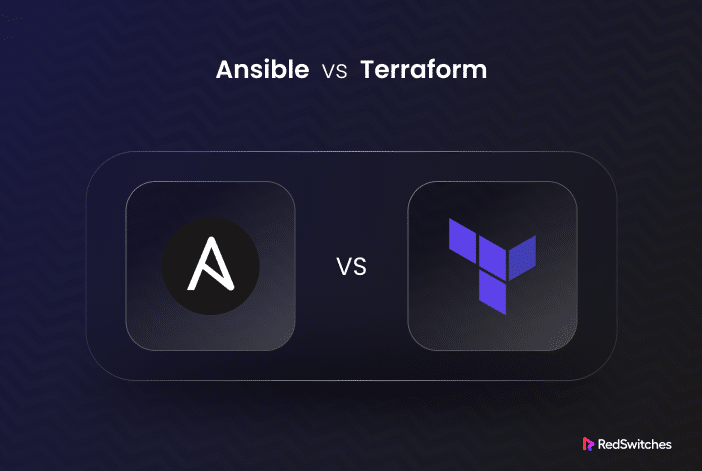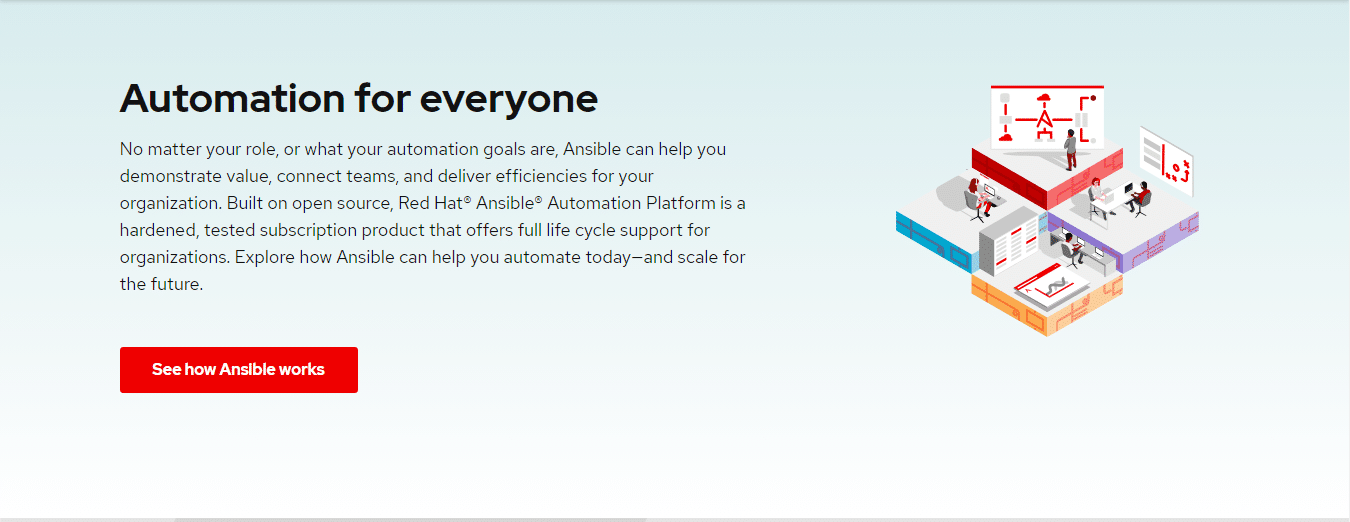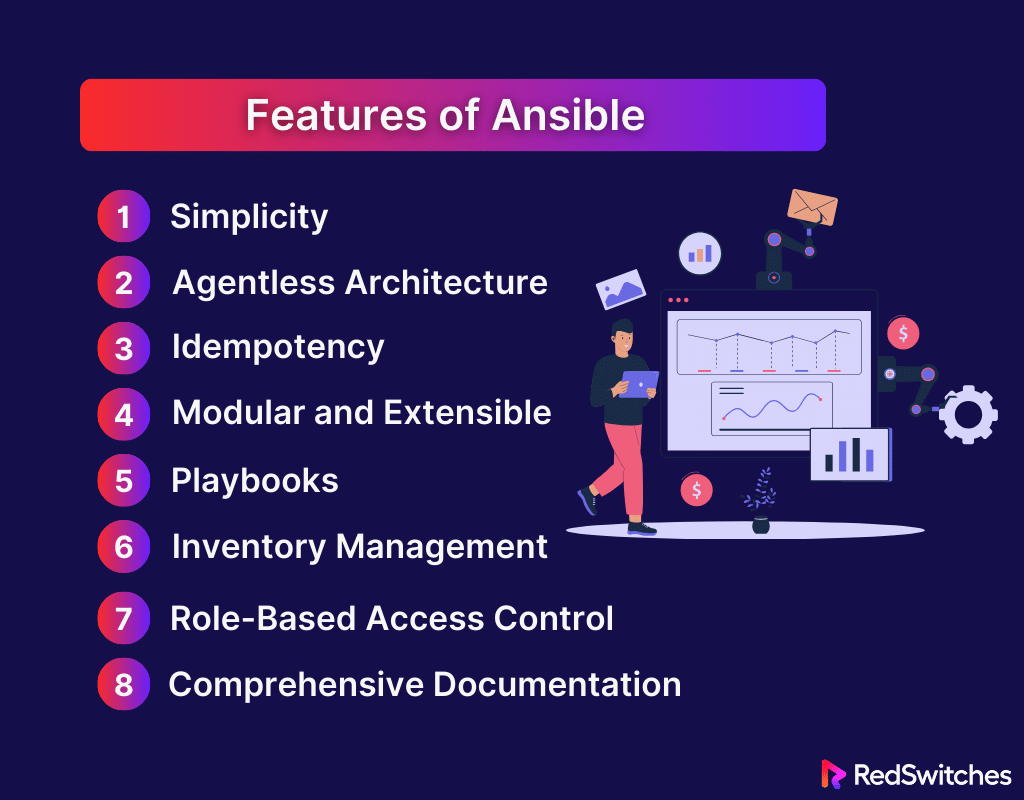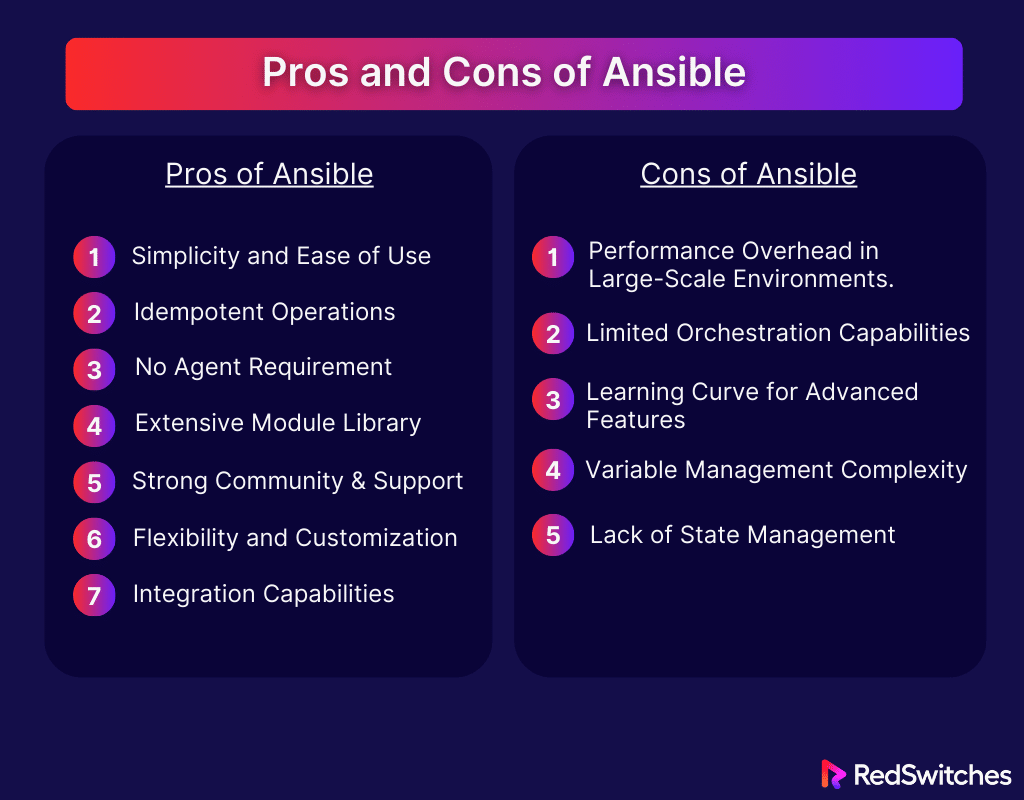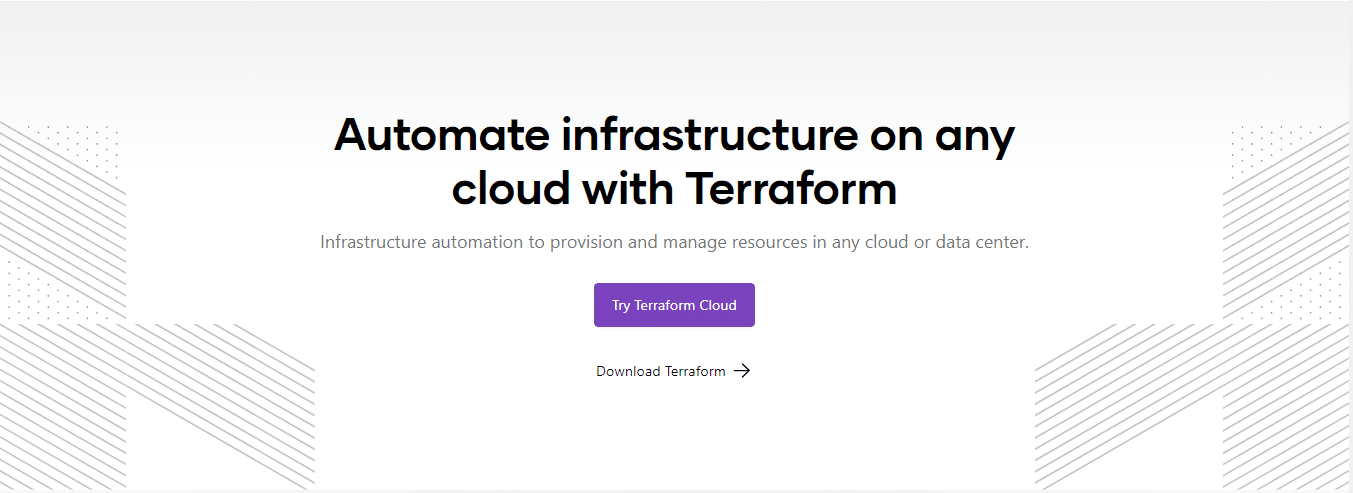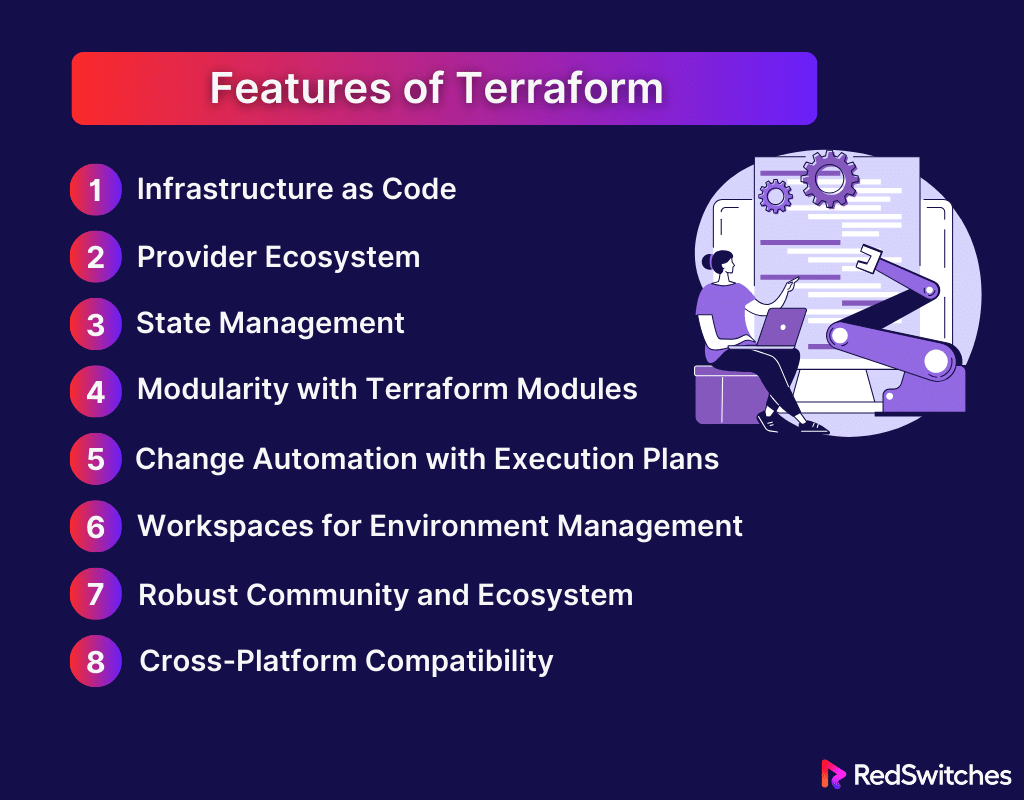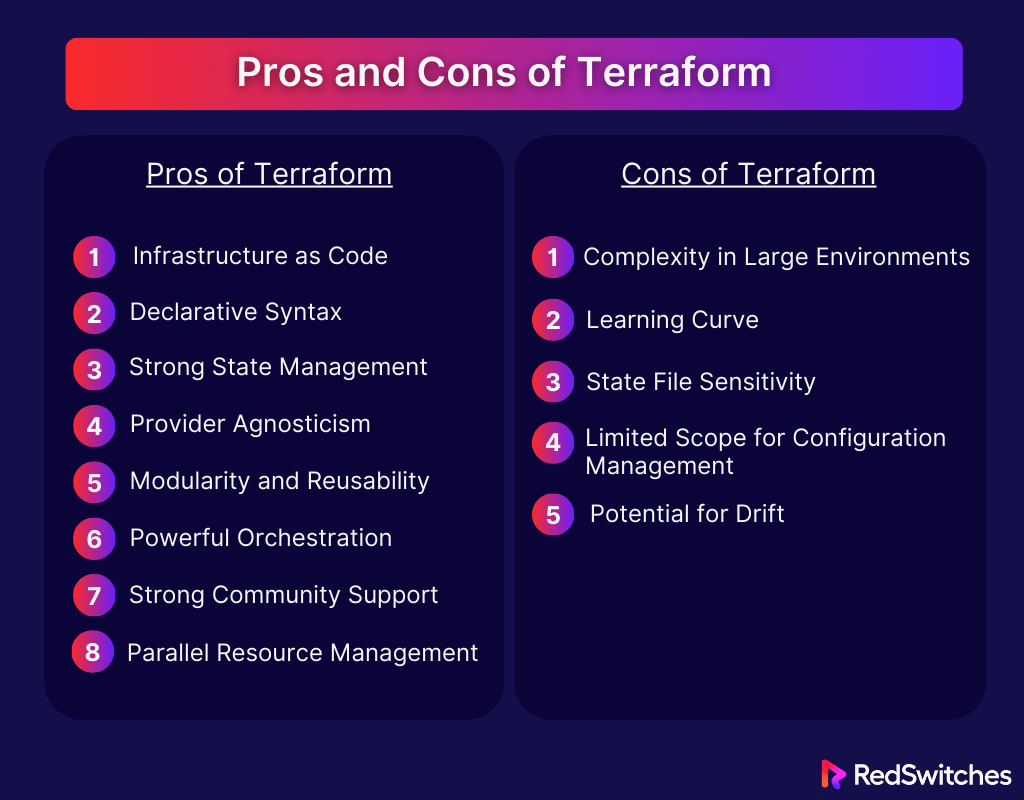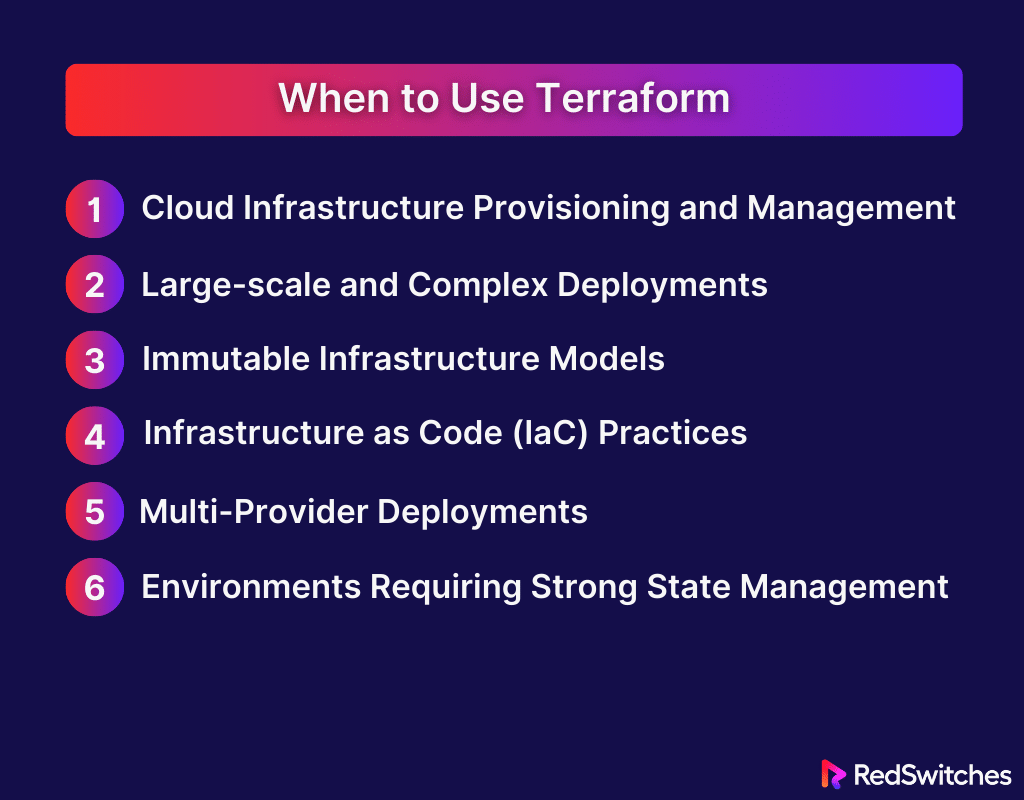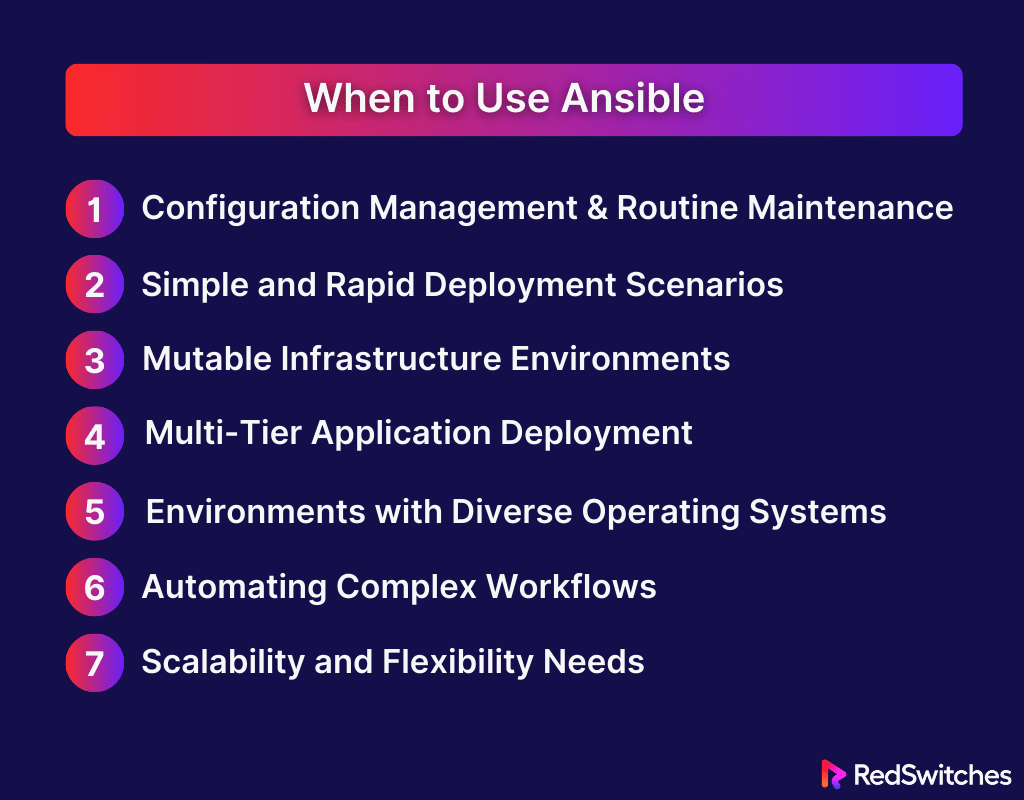Key Takeaways
- Terraform and Ansible are popular IaC tools with distinct focuses: Terraform on orchestrating infrastructure and configuration management.
- Ansible uses YAML syntax for its playbooks, making it accessible and easy to understand for automating provisioning and configuration tasks.
- Terraform uses HCL (HashiCorp Configuration Language), offering a declarative approach to infrastructure management suited for complex deployments.
- Ansible is a good choice for environments where configuration management and routine maintenance are key, thanks to its simple, agentless architecture.
- Terraform is better for scenarios requiring infrastructure as code (IaC) practices, particularly in cloud environments and large-scale deployments.
- Terraform state management allows it to track and manage the lifecycle of infrastructure resources efficiently, which is crucial for dynamic cloud infrastructures.
- Ansible can also handle multi-tier application deployments effectively, leveraging its procedural model to manage tasks in a specific sequence.
- Terraform and Ansible can be used together, combining Terraform’s infrastructure orchestration with Ansible’s configuration management for comprehensive automation.
- Ansible focuses on simplicity and ease of use, with a strong community and ecosystem supporting its modular and extensible design.
- Terraform is a tool for those looking to adopt a cloud-centric approach, managing infrastructure across multiple providers and ensuring consistency through its state files.
Ansible and Terraform are two big names in the IT automation world. They both help automate IT tasks but in different ways. People often discuss which is better, “Ansible vs Terraform,” because each has its style and benefits for making IT work easier.
This article will take a close look at both Ansible and Terraform. We’ll compare them in detail, not just what’s on the surface but how they work and what they’re best for. Whether you know a lot about IT, manage IT teams, or just like learning about new tech, this will help you understand the differences between Ansible and Terraform. This way, you can make smart choices in IT automation.
Let’s dive into the details of Ansible and Terraform. We’ll see what makes each special, the hurdles they face, and when it’s best to use each one in the world of automating IT tasks.
Table Of Contents
- Key Takeaways
- What is Ansible?
- What is Terraform?
- Ansible vs Terraform: Unveiling 8 Distinct Differences
- Ansible vs Terraform: Orchestration vs. Configuration Management
- Ansible vs Terraform: Approach and Architecture
- Ansible vs Terraform: Primary Function
- Terraform or Ansible: Mutable vs Immutable Infrastructure
- Terraform or Ansible: State Management
- Terraform vs Ansible: Language Used
- Ansible vs Terraform: Cloud vs. On-Premises
- Ansible vs Terraform: Community and Ecosystem
- When to Use Terraform
- When to Use Ansible
- Which Should You Choose?
- Conclusion
- FAQs
What is Ansible?
Credits: Ansible
Ansible is a simple yet powerful tool in the big world of IT automation. It was created because people needed an easy-to-use tool to handle complex IT jobs. Now, many organizations choose Ansible as their go-to tool.
At its heart, Ansible is a free tool that helps automate IT tasks like setting up software and managing configurations. It’s great for automatically setting up and running applications, services, and other IT setups.
One of the cool things about Ansible is that it doesn’t need any special software on the computers it looks after. This makes it easy to start using because you don’t have to install anything extra.
Ansible is also designed to be modular, using ‘roles’ and ‘playbooks.’ This setup lets people reuse code and manage complicated tasks more easily. This saves time and makes it easier for teams to work together by sharing and reusing pieces of code.
Also, read Nomad vs Kubernetes – Best Container Orchestration Tool for 2024
Features of Ansible
Ansible, renowned for its simplicity and effectiveness, brings a suite of features that make it a standout choice in IT automation. These features contribute to its ease of use and ability to efficiently manage complex IT environments. Let’s explore some key features that define Ansible:
1. Simplicity at Its Best
One of the shining stars in Ansible’s feature set is its remarkable simplicity. Picture this: You’re crafting automation scripts with YAML, an intuitive language that feels like writing a to-do list. This user-friendliness significantly flattens the learning curve, making Ansible a tool for the experts and a friend to beginners. Say goodbye to complex scripting and hello to clarity and ease!
2. Agentless Architecture: A Breath of Fresh Air
Wave goodbye to the hassle of installing agents on every machine you manage! Ansible’s agentless architecture is like a breath of fresh air in the world of automation. It smartly leverages SSH for Unix-like systems and WinRM for Windows, making the setup process as smooth as silk. This means less overhead, fewer maintenance headaches, and a much cleaner infrastructure management approach.
3. Idempotency: The Magic of ‘Do No Harm’
Ever heard of the magic trick where something happens only once and never more than needed? That’s idempotency for you, and Ansible is a master at it! Run a playbook once, and it will make the necessary changes. Rerun it, and it will gently step back if everything’s already in place. This ensures stability and reliability, making your automation tasks safe and sound.
4. Modular and Extensible: The Building Blocks of Automation
Imagine having a toolbox where each tool can be customized or swapped out as needed. That’s Ansible’s modular and extensible design. With a vast array of built-in modules for every task under the sun and the ability to craft your own, Ansible is like the Lego of automation tools – endlessly adaptable and infinitely creative.
5. Playbooks: The Heart of Your Automation Journey
At the heart of Ansible’s magic are its Playbooks. Think of them as your automation blueprints, guiding your infrastructure and applications to their desired states precisely and gracefully. Whether deploying applications, managing configurations, or orchestrating complex workflows, playbooks are your roadmap to a streamlined and efficient automation landscape.
6. Inventory Management: Knowing Your Domain
Knowledge is power, and in Ansible’s world, that comes in inventory management. It’s like having a detailed map of every server, machine, and system in your network. With Ansible’s dynamic inventory capability, your map is always up-to-date, ensuring your automation scripts hit suitable targets every time.
7. Role-Based Access Control: Keep It Secure
Security is paramount, and Ansible understands this. Its role-based access control ensures that only the right eyes and hands get to work on specific tasks. It’s like having a VIP list for your automation tasks, where only the authorized personnel get access, keeping your systems secure and your mind at peace.
8. Comprehensive Documentation: Your Guidebook
Last but not least, Ansible’s comprehensive documentation is like having an expert by your side. Whether you’re troubleshooting, learning a new feature, or diving deep into advanced topics, the documentation is your go-to guidebook, ensuring you’re never lost in your automation journey.
In summary, Ansible isn’t just an automation tool; it’s a gateway to a world of efficiency, simplicity, and reliability. Whether you’re a seasoned pro or just starting, Ansible is ready to transform your IT landscape into a well-oiled machine!
Also Read: Unraveling the Dynamics of Terraform vs Kubernetes
Pros and Cons of Ansible
While Ansible is a highly regarded tool in IT automation, it, like any technology, comes with its strengths and limitations. Understanding these pros and cons is crucial for organizations and individuals to determine if Ansible aligns with their needs and operational contexts.
Pros of Ansible
- Simplicity and Ease of Use: Ansible’s straightforward YAML syntax and agentless architecture make it easy to set up and use, even for those new to automation.
- Idempotent Operations: The idempotent nature of Ansible ensures that repeated playbook executions do not cause unexpected side effects, leading to more reliable and predictable automation.
- No Agent Requirement: Being agentless, Ansible eliminates the need to install and maintain agents on managed nodes, simplifying management and reducing system overhead.
- Extensive Module Library: Ansible’s large collection of modules allows for easy automation of various tasks across different environments.
- Strong Community and Support: With a large and active community, users of Ansible have access to a wealth of resources, including modules, plugins, and comprehensive documentation.
- Flexibility and Customization: Ansible’s modular design and the ability to write custom modules make it highly adaptable to various environments and requirements.
- Integration Capabilities: Its ability to integrate with other DevOps and IT tools makes Ansible a versatile part of broader IT workflows and ecosystems.
Cons of Ansible
- Performance Overhead in Large-Scale Environments: Ansible’s model can lead to performance bottlenecks in large infrastructures due to its reliance on SSH and the lack of agents.
- Limited Orchestration Capabilities: Ansible’s capabilities in complex orchestration scenarios can be somewhat limited compared to specialized orchestration tools.
- Learning Curve for Advanced Features: While Ansible is easy to start, mastering its more advanced features and custom module development can require a significant investment in learning and practice.
- Variable Management Complexity: Managing variables and secrets in Ansible can become complex, especially in large projects with multiple environments.
- Lack of State Management: Unlike Terraform, Ansible does not maintain a state of the system, which can be a drawback in managing resources that need a state record over time.
What is Terraform?
Credits: Terraform
Terraform is like a game-changer in the world of coding for infrastructure, or what’s known as Infrastructure as Code (IaC). It’s a tool made by HashiCorp that’s really good at setting up and managing complex setups, whether in the cloud or on your own premises.
Terraform lets you write down how you want your infrastructure to look using a special kind of code. This can be for setting up computers, networks, storage – anything you need. The cool part is that you can keep track of these setups like you do with other code: change them, share them, and use them again.
Terraform works by telling it what you want the end result to look like, and it figures out how to get there. This is different from other tools, where you have to spell out every step of the way.
Another big plus is that Terraform doesn’t care which service provider you use. It can work with all the big cloud services like AWS, Azure, and Google Cloud Platform, and also with things you run yourself. This makes it really handy for working with lots of different cloud services at the same time.
Features of Terraform
With its innovative approach to infrastructure as code, Terraform offers a rich set of features that cater to the diverse needs of modern infrastructure management. These features highlight Terraform’s strengths in provisioning and managing infrastructure and underscore its role as a critical player in cloud and on-premises infrastructure automation. Let’s delve into some of the most significant features of Terraform:
1. Infrastructure as Code: Blueprint of Your IT Landscape
Imagine describing your entire IT infrastructure with code. That’s the magic of Terraform’s Infrastructure as Code (IaC) approach. You write configurations in a simple, human-readable language, and Terraform turns them into reality. This means you can version, track, and replicate your infrastructure with the same ease as managing your source code. A true game-changer for consistency and efficiency!
2. Provider Ecosystem: A Universal Remote for Cloud Services
Terraform’s provider ecosystem is like having a universal remote control for various cloud services. Whether you’re working with AWS, Azure, Google Cloud, or others, Terraform has a provider for that. This vast and ever-growing ecosystem allows you to manage diverse resources across multiple platforms seamlessly. One tool, limitless possibilities!
3. State Management: The Art of Keeping Track
In the dynamic world of cloud infrastructure, keeping track of the current state is crucial. Terraform’s state management is a meticulous librarian who remembers every detail of your infrastructure. It helps plan, apply, and predict changes, ensuring your infrastructure evolves accurately and predictably.
4. Modularity with Terraform Modules: Building Blocks for the Cloud
Think of Terraform modules as the building blocks for your cloud infrastructure. They allow you to package configurations into reusable components. This speeds up the development process, ensures consistency, and reduces errors. It’s like having a set of custom templates at your disposal, ready to deploy and scale as needed.
5. Change Automation with Execution Plans
Terraform’s execution plans take the guesswork out of infrastructure changes. Before applying any changes, Terraform shows you a preview detailing what will happen when the plan is executed. This transparency and predictability make managing changes less of a gamble and more of a strategic maneuver.
6. Workspaces for Environment Management
Handling multiple environments (like development, staging, and production) can be a juggling act. Terraform’s workspaces simplify this by allowing you to manage these environments as separate workspaces under the same configuration. This feature provides a clean, organized way to manage and scale your infrastructure across different stages and conditions.
7. Robust Community and Ecosystem
Behind Terraform is a robust community and ecosystem. From official documentation to community-contributed modules and plugins, the wealth of resources available makes Terraform not just a tool but a thriving ecosystem. Whether you’re seeking support, new ideas, or collaboration, Terraform’s community is a treasure trove of knowledge and resources.
8. Cross-Platform Compatibility: Write Once, Deploy Anywhere
Terraform’s cross-platform compatibility ensures you can manage infrastructure on any cloud or platform with the same tools and configurations. This write-once, deploy-anywhere approach simplifies multi-cloud strategies and ensures consistent deployment across various platforms.
Terraform is more than just an infrastructure automation tool; it’s a complete ecosystem that empowers you to build, change, and version your infrastructure safely and efficiently. It’s the architect, the builder, and the caretaker of your IT infrastructure all rolled into one.
Also Read An Introduction to Terraform Variables
Pros and Cons of Terraform
While a powerful and versatile tool in the realm of infrastructure as code, Terraform has advantages and drawbacks. Understanding these can help organizations and individuals make informed decisions about their suitability for their specific infrastructure management needs.
Pros of Terraform
- Infrastructure as Code: Terraform’s ability to manage infrastructure using code allows easy versioning, repeatability, and reuse. This leads to more efficient and error-free deployments.
- Declarative Syntax: The declarative nature of the HashiCorp Configuration Language (HCL) used by Terraform allows users to focus on the infrastructure’s end state without planning the steps to achieve it.
- Strong State Management: Terraform’s state management capability maps real-world resources to the configuration, crucial for managing complex infrastructures and tracking changes over time.
- Provider Agnosticism: The ability to work with a wide range of providers makes Terraform highly adaptable to various environments, from cloud platforms to on-premises solutions.
- Modularity and Reusability: Terraform modules promote reusability and better organization of infrastructure code, which is particularly beneficial for managing large-scale infrastructures.
- Powerful Orchestration: Terraform is designed for infrastructure orchestration, efficiently handling complex dependencies, unlike many configuration management tools.
- Strong Community Support: As an open-source tool, Terraform benefits from a large and active community, providing extensive resources, modules, and third-party integrations.
- Parallel Resource Management: Terraform’s parallel creation and management of resources can significantly speed up infrastructure deployment times.
Cons of Terraform
- Complexity in Large Environments: Managing large and complex infrastructures can be challenging, especially when dealing with intricate dependencies and state files.
- Learning Curve: While Terraform’s HCL is user-friendly, mastering Terraform, especially for advanced features, requires a significant time investment.
- State File Sensitivity: Terraform’s state file is critical and sensitive. Managing it, particularly in team environments, requires careful handling to avoid conflicts or data loss.
- Limited Scope for Configuration Management: Terraform is primarily an infrastructure provisioning tool, and its capabilities in configuration management are not as extensive as specialized tools like Ansible.
- Potential for Drift: Since Terraform manages infrastructure based on the state file, any manual changes made outside of Terraform can lead to drifts from the expected state, which can be challenging to reconcile.
Ansible vs Terraform: Unveiling 8 Distinct Differences
Credits: Freepik
In IT automation, Terraform vs Ansible are two titans with unique strengths and approaches. Understanding the critical differences between Ansible vs Terraform is essential for professionals navigating the complexities of modern IT environments. This concise exploration highlights eight fundamental distinctions, emphasizing each tool’s capabilities and ideal use cases, guiding you to make an informed choice in your automation journey.
Ansible vs Terraform: Orchestration vs. Configuration Management
A critical distinction in the Ansible vs Terraform debate lies in their core functions: orchestration and configuration management.
Ansible
Ansible primarily excels in configuration management. It is designed to ensure that computer systems and software look and function as they should. Ansible automates the process of software application installation, system updates, and the overall maintenance and management of a computing environment.
This includes managing files, installing packages, and running tasks on client nodes. Ansible achieves this through playbooks – a series of tasks executed in a particular sequence, ensuring systems are configured to a specific state. It’s particularly effective in environments where maintaining a consistent state across many systems is crucial.
Terraform
Terraform, in contrast, is focused on orchestration. It is more about managing the lifecycle of infrastructure. This includes provisioning, changing, and updating resources in an orderly and predictable manner.
Terraform’s strength lies in its ability to handle complex infrastructure setups and efficiently manage dependencies between infrastructure components. It defines infrastructure as code, allowing you to create, modify, and version entire cloud and on-premises environments.
Terraform’s approach is advantageous when complex infrastructure needs involve multiple components, such as networks, virtual machines, and storage, that must be deployed and managed synchronized.
While Ansible is a champion in ensuring that the systems are configured correctly and consistently, Terraform is adept at orchestrating and managing the lifecycle of complex infrastructures. This fundamental difference in focus – Ansible’s configuration management vs Terraform’s orchestration – is a key consideration when choosing between the two for specific IT automation needs.
Also Read GitOps: A Collaborative Approach to Workload Management and Collaboration
Ansible vs Terraform: Approach and Architecture
The approach and architecture of Ansible vs Terraform further accentuate their differences, making each uniquely suited to different aspects of IT automation.
Ansible
Ansible’s approach is based on a procedural model. It operates on an agentless architecture, which means it does not require any specific software to be installed on the nodes it manages. Instead, Ansible connects to nodes using SSH (for Unix-based systems) or WinRM (for Windows), and pushes out small programs called “Ansible modules” to execute tasks.
These modules are removed once the tasks are completed, leaving no residue. This architecture makes Ansible lightweight and easy to deploy. The procedural model of Ansible requires defining the exact steps or tasks that need to be performed. This makes Ansible intuitive and straightforward, as the execution order is transparent and predictable.
Terraform
Terraform, in contrast, adopts a declarative approach based on an immutable infrastructure model. It works by declaring the desired end state of the infrastructure in configuration files written in HCL (HashiCorp Configuration Language).
Terraform then works out how to achieve that state. This can involve creating new resources or modifying existing ones. Unlike Ansible, Terraform maintains a state file, which tracks the state of managed resources.
This state management is crucial for Terraform to perform updates and changes to the infrastructure without duplicating resources. The declarative approach of Terraform is advantageous in managing complex infrastructures where understanding and tracking the relationships between resources are essential.
Ansible’s procedural, agentless architecture is ideal for straightforward task execution and configuration management, while Terraform’s declarative approach and state management. excel in managing complex, large-scale, and dynamic infrastructures.
Understanding these architectural differences is pivotal in determining the right tool – Ansible vs Terraform – for your specific infrastructure and automation requirements.
Ansible vs Terraform: Primary Function
The primary functions of Ansible vs Terraform distinctly set them apart in the automation ecosystem, defining their roles and capabilities.
Ansible
Ansible is primarily a configuration management tool. Its primary function is to automate the configuration of systems and software. Ansible ensures that computer systems and applications are set up and maintained in the desired state.
This includes tasks like setting up users, installing and updating software packages, and managing services on a system. Ansible is designed to bring systems to a desired state and maintain them, which is essential in environments where consistency across numerous systems is critical.
Terraform
On the other hand, Terraform is fundamentally an infrastructure as code (IaC) tool for building, changing, and versioning infrastructure. Its primary role is in providing and managing infrastructure resources such as physical machines, VMs, network switches, containers, and more.
Terraform allows you to define infrastructure in a high-level configuration language, which it then uses to create an execution plan to build the infrastructure as described. This makes Terraform highly effective in managing the lifecycle of a wide array of infrastructure resources, especially in cloud environments.
While Ansible’s primary function revolves around configuration management, ensuring systems are configured and maintained properly, Terraform’s role is centered on infrastructure provisioning and management, focusing on the creation and lifecycle management of infrastructure resources.
This distinction in primary function – Ansible’s configuration management vs Terraform’s infrastructure provisioning – is a key factor to consider when choosing between these two tools.
Terraform or Ansible: Mutable vs Immutable Infrastructure
A significant difference between Ansible vs Terraform lies in their approach to infrastructure management, specifically in terms of mutable vs immutable infrastructure.
Ansible
Ansible is aligned with the concept of mutable infrastructure. This approach involves making changes to an existing infrastructure. Ansible modifies the existing servers when updates or changes are required to match the desired state.
This is often done by updating configurations, installing new software, or performing other maintenance tasks. Mutable infrastructure is generally easier and more straightforward for small-scale or simpler environments, where changes are not too frequent or complex.
Terraform
Terraform, in contrast, is built around the idea of immutable infrastructure. In this model, instead of modifying the existing infrastructure, new resources are created to replace old ones whenever a change is needed.
This approach minimizes the risks of configuration drifts and inconsistencies, as the entire infrastructure can be rebuilt from a known configuration. Immutable infrastructure is particularly beneficial in cloud environments and large-scale deployments where consistency and predictability are paramount.
Understanding these approaches – Ansible’s mutable infrastructure vs Terraform’s immutable infrastructure – is crucial when selecting the right tool. Ansible’s approach is suited for environments where gradual changes and updates are the norms.
At the same time, Terraform is ideal for scenarios where infrastructure needs to be scalable, consistent, and replicated across various environments.
Also read CentOS vs Fedora: Unveiling the Differences | A Battle of Linux Titans
Terraform or Ansible: State Management
How Ansible vs Terraform handles state management significantly differentiates them, influencing their use in IT environments.
Ansible
Ansible does not inherently maintain a state of the systems it manages. It operates on a stateless model, where each playbook run is independent. Ansible relies on the system’s current state to determine the actions needed to bring it to the desired state.
This approach means Ansible does not track changes or the history of the changes it applies. While this statelessness makes Ansible simpler and easier to understand, it can also lead to complexities in tracking and managing the state of systems over time, especially in large and dynamic environments.
Terraform
Terraform, in contrast, is heavily reliant on state management. It maintains a state file that records the current state of its infrastructure resources. This state file is crucial for Terraform’s operation, as it maps the infrastructure to the configuration, tracks changes, and helps plan future changes.
The state file allows Terraform to determine what has changed and what actions must be taken to achieve the desired state. This feature is particularly important for managing large-scale and complex infrastructures, as it provides a clear understanding of the current state and a record of how it has evolved.
In essence, the difference in state management – Ansible’s stateless model vs Terraform’s stateful approach – plays a significant role in how they are utilized.
Ansible is suitable for environments where state management is neither critical nor externally managed. In contrast, Terraform is essential for scenarios where understanding and maintaining the state of infrastructure resources is crucial.
Terraform vs Ansible: Language Used
The choice of language in Ansible vs Terraform affects their usability and shapes how they are integrated into IT workflows.
Ansible
Ansible uses YAML (Yet Another Markup Language) for its playbook scripts. YAML is a human-readable data serialization language known for its simplicity and ease of use. This choice makes Ansible playbooks straightforward to write and understand, even for those new to automation or who do not have a strong programming background. The use of YAML in Ansible aligns with its philosophy of simplicity and ease of use, making it accessible to a broader audience.
Terraform
Terraform, on the other hand, uses the HashiCorp Configuration Language (HCL). HCL is a declarative language designed specifically for describing infrastructure as code. While HCL has a steeper learning curve than YAML, it offers greater expressiveness and flexibility, particularly in defining and managing complex infrastructures.
HCL’s syntax is designed to be both human-readable and machine-friendly, which is essential for Terraform’s use in defining and managing the entire lifecycle of infrastructure resources.
The choice of language – Ansible’s YAML vs Terraform’s HCL – reflects their respective focuses and strengths. Ansible’s use of YAML caters to its simplicity and ease of use goal, particularly in configuration management.
Terraform’s HCL, while more complex, aligns with its capability to manage complex and diverse infrastructure environments effectively.
Also Read DevOps Best Practices: 10 Best Practices Inside
Ansible vs Terraform: Cloud vs. On-Premises
The versatility of Ansible vs Terraform in handling cloud and on-premises environments is another area where they diverge, each offering unique capabilities tailored to these distinct infrastructures.
Ansible
Ansible is highly adaptable and can be used in cloud and on-premises environments. Its agentless architecture and SSH or WinRM for communication make it suitable for managing various systems, regardless of location.
Ansible’s strength in configuration management makes it particularly effective in on-premises environments where existing infrastructure needs to be managed and maintained. Additionally, with its wide range of modules, including those for various cloud providers, Ansible can automate tasks in cloud environments, making it a versatile tool for hybrid setups.
Terraform
With its focus on infrastructure as code, Terraform is exceptionally well-suited for cloud environments. It provides and manages cloud resources across various platforms (AWS, Azure, GCP, etc.). Terraform’s ability to define and manage entire cloud infrastructures declaratively aligns perfectly with the dynamic and scalable nature of cloud services.
While Terraform can also manage on-premises resources, its true power and efficiency are most evident in cloud-based deployments, where it can leverage the full scope of cloud provider APIs to manage resources.
In summary, when comparing Ansible vs Terraform in the cloud vs on-premises, Ansible emerges as a more flexible tool across both environments, especially strong in on-premises configuration management. In contrast, Terraform is predominantly favored for cloud environments, where its infrastructure provisioning and management capabilities are in high demand.
Ansible vs Terraform: Community and Ecosystem
The community and ecosystem surrounding Ansible vs Terraform are integral to their development, support, and adoption, and each has cultivated a unique environment that reflects its usage and capabilities.
Ansible
Ansible has built a robust and diverse community since its inception. Being open-source and widely used for configuration management and application deployment, it has attracted a broad spectrum of users – from system administrators to developers.
The Ansible community contributes a vast array of modules and plugins, crucial in extending its capabilities to new technologies and platforms. Additionally, Ansible’s integration with Red Hat has expanded its enterprise support and resources after its acquisition. The extensive documentation, active user forums, and regular community meetups make Ansible’s ecosystem rich and accessible for beginners and experienced users.
Terraform
While younger than Ansible’s, Terraform’s community is rapidly growing, particularly among cloud professionals and infrastructure engineers. Terraform’s focus on infrastructure as code for cloud environments has made it a go-to tool in the DevOps and cloud engineering spaces.
The Terraform community is highly active in contributing to its provider ecosystem, which is vital for Terraform’s ability to support a wide range of cloud platforms and services. HashiCorp, the company behind Terraform, actively fosters the community, providing extensive documentation, hosting regular conferences, and engaging in open-source contributions. This has led to a vibrant ecosystem constantly evolving with the latest trends in cloud computing.
Finding the difference between Terraform and Ansible in regards to community and ecosystem. Both boast thriving communities and ecosystems, catering to different audiences. Ansible’s community is broad, reflecting its wide applicability in various IT environments, while Terraform’s community is more specialized, focusing on cloud infrastructure and modern DevOps practices.
Here’s a summarized comparison table highlighting Ansible vs Terraform 8 key differences:
Also Read A Short Introduction to DevOps
When to Use Terraform
In the discussion of Ansible vs Terraform, understanding the specific scenarios where Terraform excels is crucial for making informed decisions in IT automation and infrastructure management. With its unique capabilities, Terraform is particularly well-suited for specific environments and tasks. Let’s delve into the scenarios where Terraform is the preferable choice.
Cloud Infrastructure Provisioning and Management
Terraform is ideal for scenarios involving the provisioning and management of cloud infrastructure. Its Infrastructure as Code (IaC) approach allows for the efficient creation, modification, and management of resources across various cloud platforms, including AWS, Azure, and Google Cloud Platform.
If your project involves setting up and maintaining cloud environments, particularly multi-cloud or hybrid setups, Terraform’s ability to handle diverse cloud services seamlessly makes it an excellent choice.
Large-scale and Complex Deployments
For large-scale infrastructures with complex dependencies, Terraform’s declarative syntax and state management capabilities are invaluable. The tool excels in orchestrating the deployment of numerous interconnected resources, ensuring that all dependencies are correctly managed and that the infrastructure is deployed predictably and reliably. This is especially important in environments where the infrastructure’s scalability and repeatability are critical.
Immutable Infrastructure Models
Terraform’s approach to immutable infrastructure makes it suitable for environments where frequent changes and consistency are paramount. Instead of modifying existing resources, Terraform creates new instances based on updated configurations, reducing the risk of configuration drift and ensuring a consistent deployment baseline.
Infrastructure as Code (IaC) Practices.
Organizations that are fully embracing IaC practices will find Terraform to be a powerful ally. Terraform’s ability to define infrastructure in code form allows for version control, peer reviews, and better infrastructure lifecycle management. This mainly benefits DevOps teams looking to automate and streamline their workflows.
Multi-Provider Deployments
Terraform’s provider-agnostic nature allows it to work with a wide range of service providers in the cloud, on-premises, and with SaaS offerings. If your project requires integration with multiple service providers or needs to manage various resource types, Terraform’s extensive provider support makes it an ideal tool.
Environments Requiring Strong State Management
The state management feature of Terraform is a boon in scenarios where tracking the state of infrastructure resources is essential. It allows for effective change management and provides insights into the current and past states of resources, which is crucial for complex deployments and troubleshooting.
In conclusion, Terraform shines in scenarios that demand robust infrastructure provisioning, complex deployments, multi-provider integration, and strong state management. While Ansible vs Terraform each have their strengths, Terraform is particularly adept at managing large-scale, complex, and dynamic infrastructures, especially in cloud environments and scenarios embracing the principles of immutable infrastructure and Infrastructure as Code.
When to Use Ansible
In the context of Ansible vs Terraform, it’s essential to recognize the situations where Ansible is particularly effective. Ansible offers specific advantages as a powerful configuration management and automation tool in certain scenarios. Let’s explore when Ansible is the most suitable for your IT needs.
Configuration Management and Routine Maintenance
Ansible is the go-to tool for configuration management tasks. It ensures that your systems and applications are configured correctly and consistently. This includes setting up users, installing software, managing files, and running tasks on many systems. It is particularly useful for routine maintenance and ensuring that existing systems remain in their desired state over time.
Simple and Rapid Deployment Scenarios
For projects that require rapid deployment and straightforward automation, Ansible’s simple and easy-to-understand syntax makes it an ideal choice. Its agentless nature and use of YAML for playbooks allow for quick setup and execution, making it suitable for scenarios where time and ease of use are critical factors.
Mutable Infrastructure Environments
In environments where changes need to be applied directly to existing infrastructure – a mutable infrastructure – Ansible is highly effective. It can manage changes and updates without replacing the whole system or infrastructure component, which is often necessary in more traditional IT environments.
Multi-Tier Application Deployment
Ansible is well-suited for deploying multi-tier applications with interdependent components. Its procedural approach allows for fine-grained control over the order of operations, ensuring that each component of the application stack is deployed and configured in the correct sequence.
Environments with Diverse Operating Systems
Ansible’s agentless architecture and wide range of modules make it highly adaptable to diverse operating systems and environments. Whether you manage Linux, Windows, or mixed environments, Ansible can handle them effectively, making it an excellent tool for heterogeneous environments.
Automating Complex Workflows
Ansible is adept at automating complex IT workflows. Its playbooks can orchestrate more complex sequences of tasks, ensuring that every step of a process is executed in the correct order and with the right conditions. This is particularly useful in continuous integration and deployment (CI/CD) pipelines and other complex IT processes.
Scalability and Flexibility Needs:
While Ansible is powerful enough to manage large-scale systems, it remains flexible and lightweight. This balance of scalability and flexibility makes it suitable for both small projects and large enterprise environments.
In summary, Ansible is the preferred choice in scenarios that demand robust configuration management, rapid and simple deployment, mutable infrastructure management, multi-tier application deployment, and complex workflow automation. In the Ansible vs Terraform comparison, Ansible stands out for its ease of use, flexibility, and effectiveness in managing diverse and complex IT environments.
Also read What is Platform Engineering? Explore 12 IDP Tools
Which Should You Choose?
Deciding between Ansible and Terraform hinges on understanding your project’s specific requirements, infrastructure goals, and the nature of your managing environments. Each tool has distinct strengths, and the choice ultimately depends on the tasks.
Consider Your Primary Requirements
If your primary need is configuration management, including consistent application deployment and system updates, Ansible is your go-to tool.
Terraform excels in infrastructure provisioning and managing cloud resources with an infrastructure-as-code approach.
Assess the Complexity and Scale of Your Infrastructure
For managing complex, large-scale, and dynamic cloud environments, Terraform offers the robustness needed.
Ansible is more suited for environments where changes are frequently applied to existing systems, especially in mutable infrastructures.
Evaluate the Need for State Management
If tracking the state of your infrastructure is crucial, particularly in cloud environments, Terraform provides strong state management capabilities.
Ansible doesn’t inherently track the state of systems, making it better for stateless management scenarios.
Consider Learning Curve and Community Support.
Ansible is known for its simplicity and ease of use, making it a good starting point for those new to automation.
While having a steeper learning curve, Terraform is well-supported by a growing community, especially among cloud and DevOps professionals.
Look at Integration with Existing Tools and Workflows.
Evaluate how each tool integrates with your current toolset. Ansible is known for its flexibility and ease of integration in various environments.
Terraform is ideal for environments heavily invested in cloud solutions and where integration with cloud providers is essential.
A Complementary Approach
In many cases, Ansible and Terraform can be used in tandem, leveraging both strengths. Terraform can manage the infrastructure on which your applications run, while Ansible can configure and manage the software on those infrastructures. Understanding the unique capabilities of each tool and how they can complement each other is critical to optimizing your IT automation and infrastructure management strategy.
Ultimately, the choice between Ansible and Terraform should align with your specific operational needs, the nature of your infrastructure, and your long-term IT strategy. Both tools are powerful in their own right, and choosing the right one—or a combination of both—can significantly enhance your automation and management capabilities.
Credits: Freepik
Conclusion
As we wrap up our exploration of Ansible vs Terraform, it’s clear that both tools have their unique strengths and ideal use cases. The choice between Ansible and Terraform ultimately depends on your specific requirements: configuration management, infrastructure provisioning, or a blend of both in your IT environment.
Whether you lean towards the simplicity and robust configuration capabilities of Ansible or the powerful infrastructure-as-code features of Terraform, the key to successful implementation lies in partnering with a knowledgeable and experienced provider. This is where RedSwitches steps in.
At RedSwitches, we understand the nuances of both Ansible and Terraform. Our team of experts is equipped to guide you through the intricate process of selecting and implementing the right tool for your needs. We’re committed to helping you streamline your operations, maximize efficiency, and stay ahead in the rapidly evolving world of IT automation.
Embrace the power of automation and unlock the full potential of your IT infrastructure with RedSwitches. Let us be your trusted partner in this journey, providing you with the expertise, support, and solutions you need to thrive in an automated world.
Ready to transform your IT landscape? Connect with RedSwitches today, and let’s embark on a journey towards seamless, efficient, and cutting-edge automation.
FAQs
Q. Is Ansible better than Terraform?
Whether Ansible is “better” than Terraform depends on the specific needs of your project. Ansible excels in configuration management and is ideal for automating and maintaining existing systems. Terraform is superior for provisioning and managing infrastructure as code, particularly in cloud environments. The choice depends on whether you need to manage the state and configuration of your systems (Ansible) or define and provision infrastructure (Terraform).
Q. Should I learn Ansible or Terraform first?
The choice of learning Ansible or Terraform first depends on your career goals and the needs of your projects. If you’re more interested in configuration management and application deployment, start with Ansible. If you focus on cloud infrastructure and infrastructure as code, then Terraform is the way to go. Both tools have different use cases, and learning can benefit a well-rounded skill set in DevOps and automation.
Q. Can we use Ansible and Terraform together?
Yes, Ansible and Terraform can be used together effectively. Terraform can provision and manage the infrastructure, while Ansible can configure and manage the state of the applications running on that infrastructure. Using them in tandem can leverage the strengths of both tools for comprehensive infrastructure deployment and management.
Q. Can you automate with Terraform?
Yes, you can automate infrastructure management with Terraform. Terraform is designed to automate infrastructure provisioning and management using infrastructure as code. It allows you to automate the creation, modification, and deletion of resources in your infrastructure, making it a powerful tool for automation in cloud and on-premises environments.
Q. What is the main difference between Terraform and Ansible?
Terraform is an open-source infrastructure as code tool for building, changing, and versioning infrastructure safely and efficiently. Ansible is an open-source tool for configuration management, application deployment, task automation, and IT orchestration.
Q. What are some key features of Ansible?
Key features of Ansible include simplicity, powerful automation capabilities, agentless architecture (no need for special software on the managed nodes), and its use of YAML syntax for writing playbooks.
Q. What are Terraform modules, and how are they used?
Terraform modules are containers for multiple resources that are used together. They allow you to group resources, making your Terraform configuration more organized, reusable, and easier to manage.
Q. What is a common use case for using Terraform and Ansible together?
A common use case is using Terraform to provision and manage the infrastructure on cloud platforms like Microsoft Azure, and then using Ansible to configure and manage the software on those infrastructures.
Q. How does Ansible help in automation?
Ansible automates software provisioning, configuration management, and application deployment, enabling DevOps practices by automating routine IT tasks, which increases efficiency and reduces errors.
Q. What makes Terraform a tool of choice for DevOps?
Terraform’s ability to treat infrastructure as code and its support for multiple service providers like AWS, Google Cloud Platform, and Microsoft Azure make it an excellent tool for DevOps, ensuring consistent and predictable infrastructure deployment.
Q. Why is Ansible considered a good option for configuration management?
Because Ansible is an open-source tool that uses YAML syntax for its playbooks, making it readable and easy to use for automating the configuration of software applications and systems.
Q. How do Terraform’s uses differ from CloudFormation?
Terraform is an open-source tool that works across multiple cloud providers (multi-cloud), whereas CloudFormation is specifically designed for Amazon Web Services (AWS). Terraform offers more flexibility in managing various cloud environments.
Q. What is the Red Hat Ansible Automation Platform, and how does it relate to Ansible?
The Red Hat Ansible Automation Platform is a comprehensive enterprise solution for building and operating automation at scale. It extends Ansible’s open-source capabilities with additional features for improved efficiency and management of complex automation workflows.
